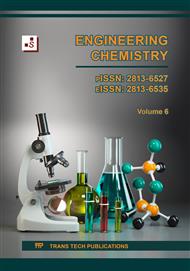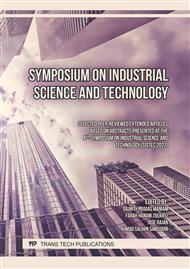[1]
L. G. David Young, V. C, USA, Safety and Efficacy of DEET and Permethrin in the Prevention of Arthropod Attack, Military Medicine. 5, 163 (1998), p.324.
DOI: 10.1093/milmed/163.5.324
Google Scholar
[2]
M. Y. Lee, Essential Oils as Repellents against Arthropods, Biomed Res Int (2018).
Google Scholar
[3]
Z. Màsum, M. Mahfud, A. Altway, Parameter for Scale-Up of Extraction Cymbopogon Nardus Dry Leaf using Microwave Assisted Hydro-Distillation. 2 (2019), pp.126-133.
DOI: 10.5937/jaes17-20216
Google Scholar
[4]
H. T. Huang, Z. H. Liao, Y. S. Wu, Y. J. Lin, Y. S. Kang, F. H. Nan, Effects of Bidens alba and Plectranthus amboinicus dietary supplements on nonspecific immune responses, growth, and resistance to Vibrio alginolyticus in white leg shrimp (Penaeus vannamei), Aquaculture. 546, 737306 (2022).
DOI: 10.1016/j.aquaculture.2021.737306
Google Scholar
[5]
A. P. Sunitha, K. Sandeep, J. Rose, P. Hajara, K. J. Saji, Carbon quantum dots synthesized from Plectranthus Amboinicus: An eco-friendly material with excellent non-linear optical properties, Mater Today Proc. 47 (2021) pp.1601-1604.
DOI: 10.1016/j.matpr.2021.04.288
Google Scholar
[6]
G. Arumugam, M. K. Swamy, U. R. Sinniah, Plectranthus amboinicus (Lour.) Spreng: Botanical, Phytochemical, Pharmacological and Nutritional Significance, Molecules. 21, 4 (2016).
DOI: 10.3390/molecules21040369
Google Scholar
[7]
T.T. Hein, N.D. Chinh, P.T. Nguyen, T.T. Van, V.D. Nguyen, B.L. Giang, N.T. Duy, Research on lemongrass oil extraction technology (Hydrodistillation, microwave-assisted hydrodistillation), Indonesian J. Chemistry. 19, 4 (2019), pp.1000-1007.
DOI: 10.22146/ijc.40883
Google Scholar
[8]
H. T. H. Nguyen, A. Rimbawanto, Prastyono, N. K. Kartikawati, H. Wu, Genetic improvement for essential oil yield and quality in Melaleuca cajuputi, Ind Crops Prod. 137 (2019), pp.681-686.
DOI: 10.1016/j.indcrop.2019.05.061
Google Scholar
[9]
X. Zhang, Y. Guo, L. Guo, H. Jiang, Q. Ji, Vitro Evaluation of Antioxidant and Antimicrobial Activities of Melaleuca alternifolia Essential Oil, Hindawi BioMed Research Inter. (2018).
DOI: 10.1155/2018/2396109
Google Scholar
[10]
D. Kostrzewa, A. Dobrzyńska-Inger, R. Reszczyński, Pilot scale supercritical CO2 extraction of carotenoids from sweet paprika (Capsicum annuum L.): Influence of particle size and moisture content of plant material, LWT Food Sci. and Tech. 136, 110345 (2021).
DOI: 10.1016/j.lwt.2020.110345
Google Scholar
[11]
H. S. Kusuma, M. Mahfud, Preliminary study: Kinetics of oil extraction from basil (Ocimum basilicum) by microwave-assisted hydrodistillation and solvent-free microwave extraction, South African J. Chemical Engineering. 21 (2016), pp.49-53.
DOI: 10.1016/j.sajce.2016.06.001
Google Scholar
[12]
H. S. Kusuma, M. Mahfud, Comparison of conventional and microwave-assisted distillation of essential oil from Pogostemon cablin leaves: Analysis and modelling of heat and mass transfer, J. Appl. Res. Med. Aromat. Plants. 4 (2017, pp.55-65.
DOI: 10.1016/j.jarmap.2016.08.002
Google Scholar
[13]
M. T. Golmakani, K. Rezaei, Comparison of microwave-assisted hydrodistillation withthe traditional hydrodistillation method in the extractionof essential oils from Thymus vulgaris L., Food Chem. 109, 4 (2008), pp.925-930.
DOI: 10.1016/j.foodchem.2007.12.084
Google Scholar
[14]
Y. S. Chen, H. M. Yu, J. J. Shie, T. J. R. Cheng, C. Y. Wu, J. M. Fang, C. H. Wong, Chemical constituents of Plectranthus amboinicus and the synthetic analogs possessing anti-inflammatory activity, Bioorg Med Chem. 22, 5 (2014), pp.1766-1772.
DOI: 10.1016/j.bmc.2014.01.009
Google Scholar
[15]
S. Pimentel-Moral, I. Borrás-Linares, J. Lozano-Sánchez, D. Arráez-Román, A. Martínez-Férez, A. Segura-Carretero, Microwave-assisted extraction for Hibiscus sabdariffa bioactive compounds, J. Pharm Biomed Anal. 156 (2018), pp.313-322.
DOI: 10.1016/j.jpba.2018.04.050
Google Scholar
[16]
G. A. Cardoso-Ugarte, G. P. Juárez-Becerra, M. E. Sosa-Morales, A. López-Malo, Microwave-assisted extraction of essential oils from herbs, J. Microwave Power and Electromagnetic Energy. 47, 1 (2013), pp.63-72.
DOI: 10.1080/08327823.2013.11689846
Google Scholar
[17]
M. E. Lucchesi, F. Chemat, J. Smadja, Solvent-free microwave extraction: An innovative tool for rapid extraction of essential oil from aromatic herbs and spices, J. Microwave Power and Electromagnetic Energy. 39 (2004), pp.135-139.
DOI: 10.1080/08327823.2004.11688514
Google Scholar
[18]
I. R. Kubra, D. Kumar, L. J. M. Rao, Emerging Trends in Microwave Processing of Spices and Herbs, Crit. Rev. Food Sci. Nutr. 56, 13 (2016), pp.2160-2173.
DOI: 10.1080/10408398.2013.818933
Google Scholar
[19]
S. Karakaya, S. N. El, N. Karagozlu, S. Sahin, G. Sumnu, B. Bayramoglu, Microwave-Assisted hydrodistillation of essential oil from rosemary,J. Food Sci. Technol. 51, 6 (2014), pp.1056-1065.
DOI: 10.1007/s13197-011-0610-y
Google Scholar
[20]
M. Azeem, T. Zaman, M. Tahir, A. Haris, Z. Iqbal, M. Binyameen, A. Nazir, S. A. Shad, S. Majeed, R. Mozuraitis, Chemical composition and repellent activity of native plants essential oils against dengue mosquito, Aedes aegypti, Ind Crops Prod. 140 (2019).
DOI: 10.1016/j.indcrop.2019.111609
Google Scholar
[21]
B. S. Park, W. S. Choi, J. H. Kim, K. H. Kim, S. E. Lee, Monoterpenes from thyme (Thymus vulgaris) as potential mosquito repellents, J. Am Mosq Control Assoc, 21, 1 (2005), pp.80-83.
DOI: 10.2987/8756-971x(2005)21[80:mfttva]2.0.co;2
Google Scholar
[22]
Y. Trongtokit, Y. Rongsriyam, N. Komalamisra, C. Apiwathnasorn, Comparative repellency of 38 essential oils against mosquito bites, Phytotherapy Research. 19, 4 (2005), pp.303-309.
DOI: 10.1002/ptr.1637
Google Scholar
[23]
A. Seyoum, K. Palsson, S. Kung, E. W. Kabiru, W. Lwande, G. F. Killen, A. Hasannali, B. G. J. Knols, Traditional use of mosquito-repellent plants in western Kenya and their evaluation in semi-field experimental huts against Anopheles gambiae: ethnobotanical studies and application by thermal expulsion and direct burning, Tropical Medicine, and Hygiene. 96 (2002), pp.225-231.
DOI: 10.1016/s0035-9203(02)90084-2
Google Scholar



